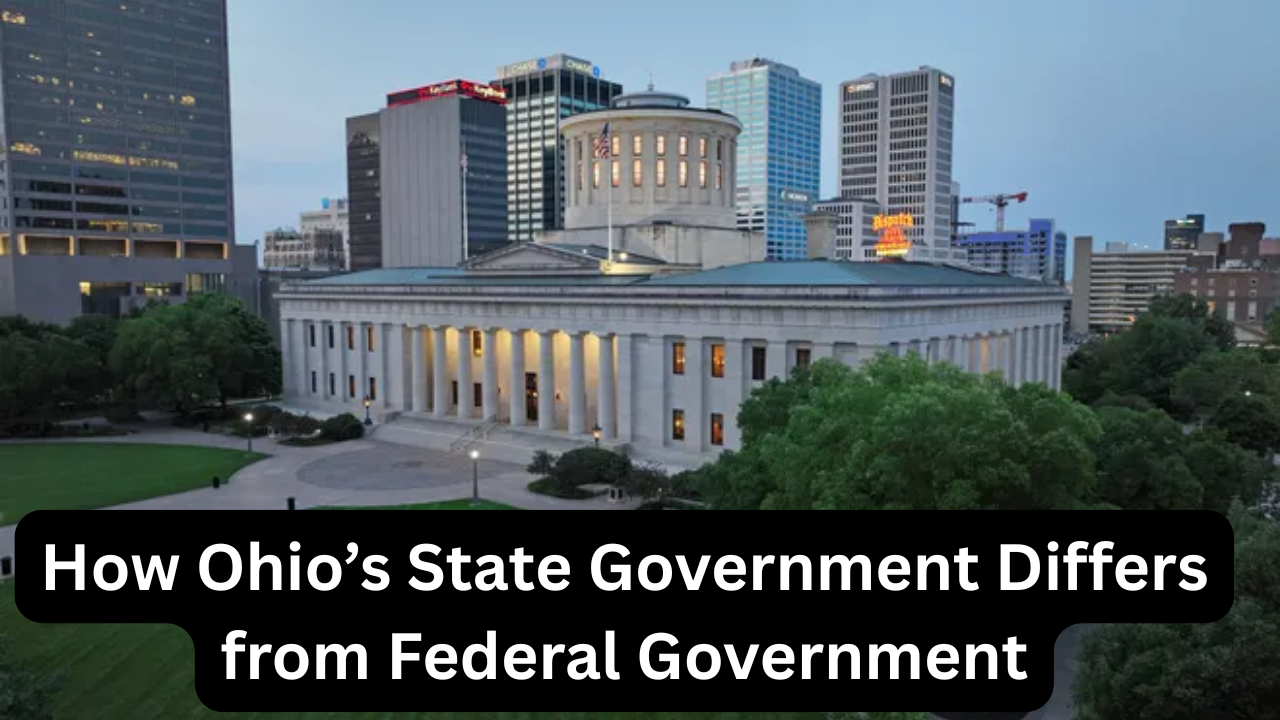
The United States is governed by multiple layers of government, primarily the federal government and state governments. While both play vital roles in shaping laws and policies, Ohio’s state government functions differently from the federal government in structure, powers, and responsibilities. Understanding these distinctions helps citizens know where decisions are made and how they affect everyday life. This article explores the key differences between Ohio’s state government and the federal government, highlighting their unique features, roles, and impact.
Structure and Composition
Both Ohio and the federal government have a system of three branches—legislative, executive, and judicial—but the makeup and size of these branches differ significantly.
- Legislative Branch
- Ohio: The Ohio General Assembly is bicameral, consisting of the House of Representatives (99 members) and the Senate (33 members).
- Federal: The U.S. Congress is bicameral as well, comprising the House of Representatives (435 members) and the Senate (100 members).
- Executive Branch
- Ohio: Led by the Governor, alongside elected officials like the Lieutenant Governor, Attorney General, and Secretary of State.
- Federal: Led by the President, with a Vice President and appointed Cabinet members.
- Judicial Branch
- Ohio: Includes the Ohio Supreme Court, Courts of Appeals, and trial courts.
- Federal: Comprises the U.S. Supreme Court, Circuit Courts of Appeals, and District Courts.
Powers and Responsibilities
Ohio’s state government handles many issues specific to the state, while the federal government addresses national and international matters.
- State Government Powers
- Education policy and funding.
- State criminal laws and law enforcement.
- Local infrastructure, such as roads and public transportation.
- Health and welfare programs at the state level.
- Conducting state elections and regulating voting procedures.
- Federal Government Powers
- National defense and foreign policy.
- Immigration and naturalization.
- Federal taxation and interstate commerce.
- Social Security, Medicare, and federal welfare programs.
- Constitutional protections and enforcement.
Lawmaking Processes
While both governments create laws through legislative bodies, the scope and procedures differ:
- Ohio’s Lawmaking
- Bills can originate in either the Ohio House or Senate.
- The Governor has veto power but can be overridden by a three-fifths legislative vote.
- Laws primarily address state-specific concerns.
- Federal Lawmaking
- Bills can start in either the House or Senate.
- The President has veto power, overridden by a two-thirds majority in both chambers.
- Laws affect the entire nation.
Election and Terms of Office
The electoral processes and term lengths differ between Ohio’s state government and the federal government.
- Ohio State Officials
- Governor serves a four-year term with a two-term limit.
- State legislators serve two-year (House) or four-year (Senate) terms.
- Elections are often held during midterms and odd years.
- Federal Officials
- President serves a four-year term with a two-term limit.
- Members of the House serve two-year terms; Senators serve six-year terms.
- Federal elections coincide with national election cycles.
Relationship with Local Governments
Ohio’s state government directly oversees counties, cities, and townships, providing laws and regulations that shape local governance. The federal government has less direct control over local governments but influences them through funding and mandates.
- Ohio passes laws that regulate local governments, education districts, and public safety.
- The federal government provides grants and enforces constitutional protections at all levels.
Fiscal Management
Both governments collect taxes but differ in tax types and spending priorities.
- Ohio State Taxes
- Income tax, sales tax, and property tax are major sources.
- Funds are allocated for state services like education, transportation, and public safety.
- Federal Taxes
- Primarily income and payroll taxes.
- Funds national defense, federal programs, and infrastructure.
Overview Table: Ohio State Government vs. Federal Government
| Feature | Ohio State Government | Federal Government | Key Difference |
|---|---|---|---|
| Legislative Bodies | Ohio General Assembly (House & Senate) | U.S. Congress (House & Senate) | Size and jurisdiction differ |
| Executive Leadership | Governor and statewide elected officials | President and appointed Cabinet | Election and roles vary |
| Judicial System | Ohio Supreme Court and state courts | U.S. Supreme Court and federal courts | Jurisdiction limited by state/federal law |
| Lawmaking | State laws, Governor’s veto override by 3/5 | Federal laws, Presidential veto override by 2/3 | Different veto override thresholds |
| Election Terms | Governor: 4 years, legislators: 2-4 years | President: 4 years, House: 2 years, Senate: 6 years | Term lengths and limits differ |
| Taxation | Income, sales, property taxes | Income and payroll taxes | Different tax structures and usage |
FAQs
Q1: Can Ohio’s laws override federal laws?
No, federal laws and the U.S. Constitution take precedence over state laws.
Q2: Who enforces laws in Ohio?
Both state law enforcement agencies and local police enforce state laws; federal agencies enforce federal laws.
Q3: Can Ohio residents vote in federal elections?
Yes, Ohio residents vote for federal offices like President, U.S. Senators, and Representatives.

